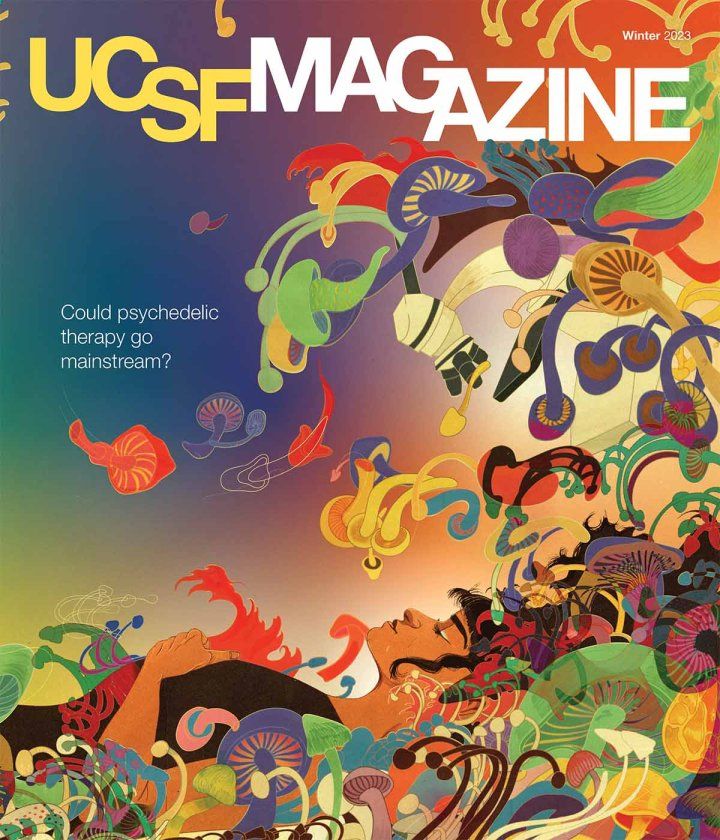
Mission: A Tobacco-Free World
Q&A with Pamela Ling, director of UCSF’s Center for Tobacco Control Research and Education

Youth smoking rates in the U.S. were at all-time lows when flavored e-cigarettes hit the market 15 years ago, sparking an epidemic of novel nicotine products. Also called vape pens, these devices heat up liquid that contains nicotine and other chemicals, creating an aerosol that’s inhaled. Pamela Ling, MD ’96, MPH, applies her research-driven social media and marketing expertise to beat the tobacco industry at its own game – and avoid similar pitfalls with cannabis.
In the 1950s, 45% of the U.S. adult population smoked. By 2020, that figure was down to 12.5%. Is tobacco still a public health crisis?
Tobacco remains the leading preventable cause of disability and death in this country, responsible for 1 in 5 deaths – 480,000 people a year.
It’s great news that smoking rates are continuing to come down. But e-cigarettes are slowing progress. Vaping is harmful and has taken over the youth market. In California, five times more young people vape than smoke cigarettes.
The U.S. Food and Drug Administration (FDA) only started regulating cigarettes and smokeless tobacco in 2009. It was another seven years before they began regulating e-cigarettes. During this time, the industry was selling fast and furiously, even coining the term “vape” to get away from negative associations with cigarettes.
Right now, young people’s use of tobacco products is a driving concern. A lot of youths who were not addicted to cigarettes started vaping – largely due to unfettered availability and marketing. In 2021, 2% of high school students nationally smoked cigarettes, but more than 11% vaped.
Juul Labs recently agreed to pay $440 million to settle an investigation by nearly three dozen states into its sales tactics to youths. Will that have an impact?
The settlement put some limits on advertising, but it only applies to Juul, which has already lost a huge percentage of the market share after bowing to pressure to drop fruit flavors. Juul look-alike brands immediately took over that niche.
So how do we get kids to stop vaping, or even better to never start?
Early in my career, I got interested in tobacco and marketing to learn how the industry convinced young people to do something that kills them. I use those strategies to improve smoking prevention and cessation by making the advice relevant and accessible to the people we’re trying to reach. For example, to address teenage vaping, we adapted the look and messaging of a smoking-cessation group-support program UCSF developed on Facebook and put it on Instagram because teenagers are not on Facebook anymore.
There’s been a lot of talk about vaping’s potential benefits – like Juul’s claim that it helps people quit smoking cigarettes. Is there science behind that?
The evidence is still in its infancy. For smoking cessation, a few studies found e-cigarettes were as effective as other nicotine replacements in controlled situations. But the reality is that most people who vape also continue smoking cigarettes, and most revert back. If someone wants to quit smoking by vaping, we have to try to mimic the situation you get in a randomized trial with close supervision and structured plans to quit. Switching on your own, going to the corner store to buy your vape products, not having any counseling support – that depresses quitting.
The reality is that most people who vape also continue smoking cigarettes, and most revert back.”
There’s also some indication that smokers who switch completely to e-cigarettes reduce their exposure to toxins, but we don’t know if that reduces meaningful outcomes like heart attacks. Some use this data to claim vaping is “safer” than smoking – but almost anything is.
What trends are you watching?
New marketing of old nicotine-cessation products for recreational use – like pomegranate-flavored gum or lozenges. Also, the expansion of vitamin vapes – B12, melatonin, CBD, aromatherapy – marketed in cute packaging as a “healthy” way to reduce stress, suppress appetite, or get antioxidants. There’s no evidence of any health benefit, and they may be dangerous – they’re still putting heated aerosols into the lungs. Because these products don’t have nicotine or psychoactive THC, they’re classified as supplements, with very little regulation. You can buy them at places like Urban Outfitters.
A tobacco-free world is the center’s mission. Is that within reach?
We’re quite hopeful that it is, particularly in California, where the smoking rate is at a historic low – about 10%. The challenge is that smoking is now concentrated in marginalized groups, like communities of color and people with mental health and substance abuse issues. These populations are targeted by industry. We’re working cooperatively with people in high-risk communities to address disparities and find solutions. Take African American smokers – 80% use menthol products. In 2020, California banned the sale of menthol and other flavored tobacco products. The industry spent millions trying to defeat the policy in a ballot initiative – but luckily in November 2022 voters upheld it.
Now that recreational cannabis use is legal in 19 states, there’s a proliferation of products. Are these good, bad, or somewhere in between?
The research is very slow to progress. With the history of medical marijuana use, especially in California, people perceive cannabis to be safe and therapeutic. I’ve had study participants say, “Secondhand cigarette smoke will kill you, but secondhand marijuana smoke, that’s medicine.” It’s not. Cannabis smoke has been shown to have cardiovascular effects similar to cigarette smoke.
There are clear evidence-based applications, such as the use of cannabinoids for nausea caused by chemotherapy. But claims that these products manage depression, anxiety, sleep, and a host of “wellness” benefits are not supported by research. Cannabis can be used legally, but we need to beware of marketing hype. There’s also growing concern about the packaging of edibles – mimicking Sour Patch Kids candy or Oreo cookies – connected to poisoning of kids.
We need to look at lessons learned from tobacco control and apply them to cannabis. Even basic things like visible warning labels and childproof packaging. We got rid of candy-flavored cigarettes over a decade ago. As we’re looking at the end of the tobacco epidemic, we need to avoid the dawn of a commercialized cannabis public health disaster.
Pamela Ling is the American Legacy Foundation Distinguished Professor of Tobacco Control and director of the UCSF Center for Tobacco Control Research and Education.




